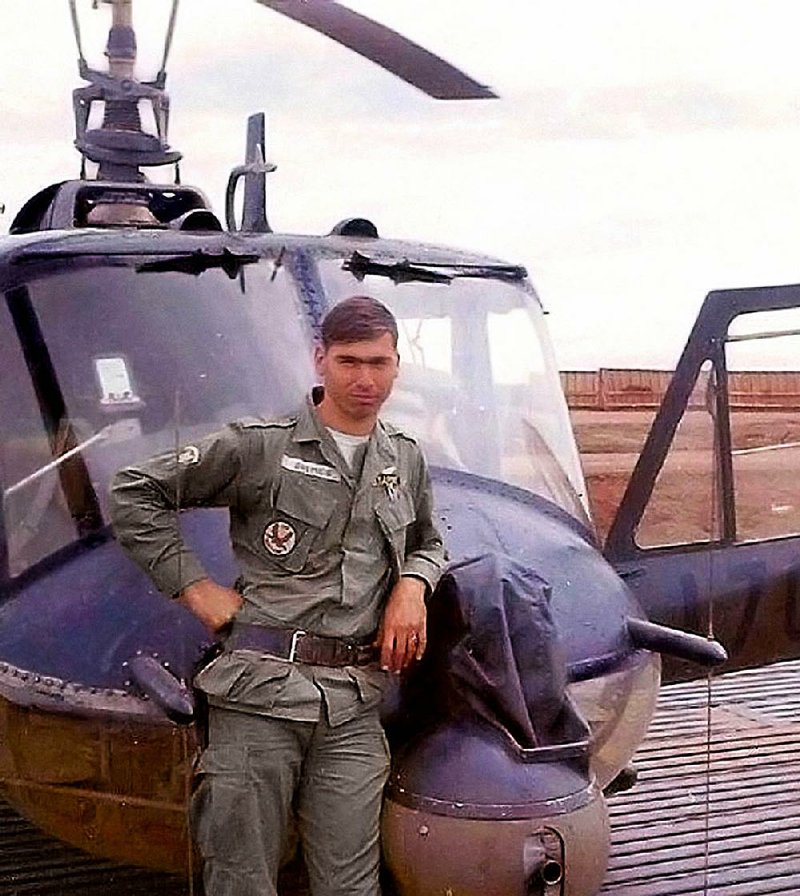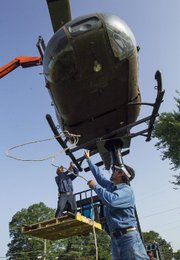The director of the Jacksonville Museum of Military History opened a thick white binder and landed on a photograph of a U.S. Army soldier, dressed in a flight suit, posing with an armored helicopter.
The man leaned against the Bell UH-1C Iroquois, unofficially known as a "Huey," with one hand on his waist and the other resting on the helicopter's nose. On the other side of the Huey was its nose art -- a skull and crossbones for the platoon that called itself "Buccaneers."
A description taped to the photo said it was taken in April 1967, when the U.S. was well into the Vietnam War.
After being damaged in Vietnam and then used by the Arkansas National Guard for the last years of its operational life, that Huey is now being restored to its appearance in the nearly 50-year-old photograph.
"It's had a pretty long history," said DannaKay Duggar, director of the Jacksonville museum. The helicopter has been on display in front of the museum for the past several years and is "in pretty bad condition," she said.
When contractors took the Huey off its pedestal Monday and transported it to an area near the Jacksonville Recycling Center, it was scuffed, and its brown-and-green paint was fading.
After being repainted numerous times, there was no longer any indication of its history as part of the Buccaneers' fleet. And that's how it would have remained if the man in the photograph hadn't shown up in Jacksonville -- decades later -- to see his helicopter for the first time since he left Vietnam in January 1968.
"As soon as I pulled into the parking lot and saw my baby, I knew," said Sam Grimes, who had been the Huey's crew chief. "I walked around it, looked at the tail number and thought, 'Yep, that's mine.'"
Grimes, now 69 and living in Snowflake, Ariz., used the Huey's serial number to track its location.
He set out to find it for "nostalgia," Grimes said. He was assigned to that helicopter for nine months and flew in it for 750 hours. In the air, he manned one of the Huey's two M-60 machine guns.
Before he showed up, museum leaders were already planning a restoration, but they didn't know the history of the Huey's insignia.
"We wanted to get as historically close as we could," Duggar said. "It had been assigned to several different units, and even though we have history of what it was assigned to and when, we didn't know the mascot. We were really just kind of waiting until we could find that out."
Before the Huey regains its identity as a Buccaneer, airmen from the Air Force Reserve's 913th Airlift Group at Little Rock Air Force Base in Jacksonville will clean, stencil and paint the helicopter. They also will replace the landing skid and a chin bubble, which is the window near the pilot's feet.
Senior Master Sgt. Harry Watson is leading the airmen who volunteered to help. He said the renovation is estimated to take a few weeks.
Once the restoration is complete, museum leaders want to make the Huey into a larger exhibit by adding statues of soldiers at its base and creating a walkway to surround it.
"This is exactly what we want it to look like," Duggar said, pointing to a drawing inside the binder.
Besides the drawing and the photos that Grimes sent after his first visit to the museum, the binder contained the helicopter's stitched-together past.
The Huey was donated to the museum by the Holbert family, which owns Little Rock-based Central Flying Service.
When Robert Fureigh of North Little Rock flew that same helicopter in the late 1970s and '80s, it was part of the Arkansas National Guard's gunship fleet. The Huey was transferred to the National Guard after its use in the Vietnam War.
Fureigh, 67, flew an identical helicopter during his year in Vietnam from 1970 to 1971.
He's now a member of North Little Rock's military relations committee and a frequent visitor to the Jacksonville museum. He calls the helicopter familiarly by its tail number, "1-5-0."
"It's satisfying," Fureigh said of the restoration. "It's an item of focus that can be a small piece of education for our younger generations about Vietnam."
According to the Vietnam Helicopter Pilots Association, approximately 11,800 helicopters were used by the U.S. during the war, and 7,000 were Hueys of 12 different varieties. More than half of the Hueys were destroyed.
Of the 696 Bell UH-1C Iroquois helicopters used in Vietnam, 415 didn't make it back, according to the association.
This particular Huey has "a lot of stories," Fureigh said.
Through research over the years, Grimes discovered the Huey was damaged in the Vietnam War twice and brought back to the U.S. each time to be rebuilt. After the war, it sat in storage until it was assigned to the Arkansas National Guard.
Grimes has visited the helicopter twice since his initial reunion, and he will see "1-5-0" in its restored state during his yearly visit next spring.
Of the restoration, Grimes said, "It's a beautiful thought."
"One of the things I've always said is that I'm glad it's not in a scrap pile," Grimes said. "I'm glad it's still around."
Metro on 06/28/2015

